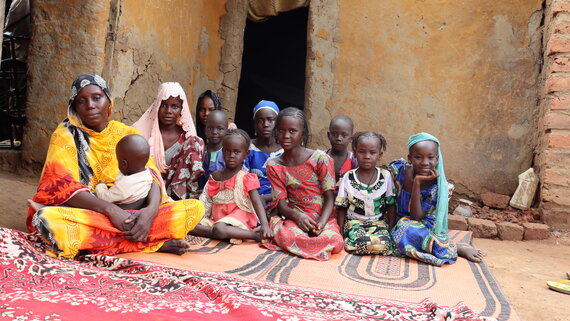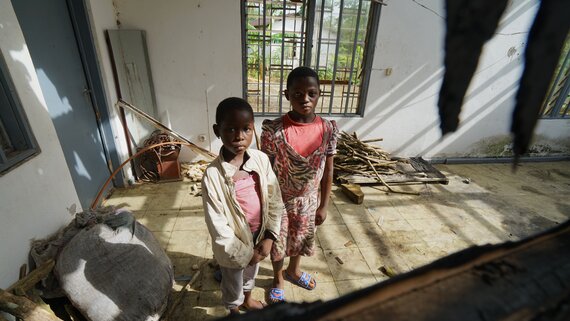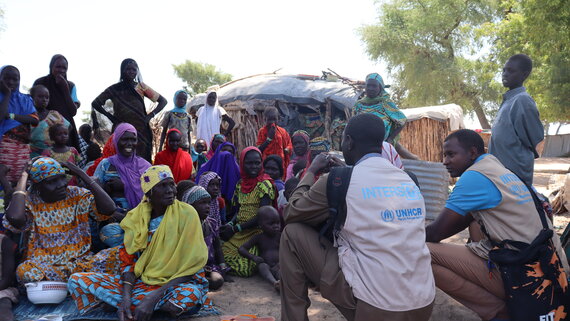Analysis of the context, crisis and needs
Nine out of ten regions of Cameroon continue to be impacted by three complex humanitarian crises: the Lake Chad basin conflict, the North-West and South-West (NWSW) crisis and the Central African Republic (CAR) refugee crisis. Humanitarian needs are compounded by structural development weaknesses and chronic vulnerabilities that further challenge the long-term recovery of the affected people. Despite the response efforts deployed, the severity of humanitarian needs in Cameroon keeps growing due to the prolonged crises, insecurity and displacement, the impact of COVID-19 as well as climate-related effects, such as floods and droughts, weakening remaining household resilience.
The number of people displaced due to the Lake Chad basin conflict continues to increase. As of 30 September 2021, over 607,000 people are displaced in the Far North, an increase of over 47,000 IDPs and returnees since September 2020.
Conflict over natural resources in the Far North has intensified. In August 2021, intercommunal clashes in Logone-Birni (Logone et Chari) over access to water displaced over 21,000 people, including almost 9,000 who sought refuge in Chad. Furthermore, the Far North region experienced exceptional flooding in 2020 and drought in 2021, severely reducing the crop yields triggering acute food shortages. This heavily affected women, who represent 71 per cent of workers in the informal agricultural sector in Cameroon. Together with the armed conflict and the socioeconomic impact of COVID-19, the effects of the natural disasters have led to a more than 70 per cent increase in projected food insecurity from 2021 to 2022. Over 900,000 people were estimated to be food insecure from June to August 2022, compared to 630,000 people for the same period in 2021. Food and access to livelihoods thus remain the main priority for displaced persons as well as host-community members in the Far North.

South-West region, Cameroon
An IDP family who have been displaced due to flooding, in the Logone et Chari division, Far North region.
OCHA/MouangeCameroon’s eastern regions are home to more than 315,000 vulnerable refugees from CAR. As of 30 September 2021, UNHCR reported the arrival of 14,034 new refugees fleeing instability in the country since December 2020. Access to livelihoods, food, WASH services and education remains limited for these refugees and their host communities. The steadily increasing number of refugees continues to exert significant pressure on natural resources and basic social services in the host areas.
The crisis in the NWSW regions has led to the displacement of over 1 million people since 2017, including to other regions of Cameroon and to Nigeria. Short-term, pendular movement continues within the two regions, but a certain return movement to the NWSW has been observed in 2021, inter alia because of a lack of service and assistance in areas of displacement.
Projected situation in 2022 and beyond
In 2022, 4 million people in Cameroon will need humanitarian assistance, including 2 million people in relation to the NWSW crisis, 1.2 million people in the Far North, and 477,000 people in relation to the CAR refugee crisis. Another 200,000 people will need humanitarian assistance due to the impact of COVID-19 and other epidemics.
Insecurity is expected to remain high in the Far North and NWSW regions in 2022 and will continue to cause population displacement exacerbating limited access to food and other essential needs.
In the NWSW regions, extended lockdowns imposed by non-State armed groups (NSAGs), NSAG attacks and military operations have caused significant humanitarian consequences. Fragmentation of NSAGs and increasing criminality have led to an ever-more fragile and dangerous environment for humanitarians to operate in. Humanitarian access is expected to remain challenging in 2022, with underfunding being an additional impediment to reach people in need.

Buea district, Cameroon
These internally displaced children fled from their village with their parents in 2018 and lived in a dilapidated house in a former plantation complex, where some 230 other villagers have found safety. The banana, rubber and coconut plantation was created in the early twentieth century in German colonial days and then taken over by The Cameroon Development Corporation, after independence in 1960. As the crisis in the north-west and south-west regions intensified, many local government workers were attacked and threatened by local anti-government armed groups, eventually forcing the closure of all plantations in the troubled regions.
OCHA/Giles ClarkeThousands of people continue to suffer from human rights violations and abuses in the NWSW. Women, men, girls and boys are acutely affected by distinct protection risks. Food and drinking water are the top priority needs for the displaced population in these two regions, followed by health and education. An estimated 700,000 students are affected by the closure of two out of three schools in the NWSW regions. Attacks on education have forced many families to send their children to the Littoral, West, and Centre regions to pursue their education. However, education remains among the top three priority needs of the displaced population in these three regions.
Response priorities in 2022
The 2022 Humanitarian Response Plan (HRP) will prioritize the most vulnerable 2.8 million people, based on an analysis of the severity of needs across sectors. A total of 1,630,000 people affected by the NWSW crisis are targeted for assistance (80 per cent of the PIN), 320,000 people affected by the CAR crisis are targeted (67 per cent of the PIN), and 776,000 people are targeted in the Far North (63 per cent of the PIN). A total of US$371.5 million is requested to meet the needs of the 2.8 million people targeted for assistance.
Cameroon HRP
In addition to meeting the most urgent needs, the approach taken in Cameroon recognizes that humanitarian needs are exacerbated by underlying structural causes, including poverty and gender disparities. The implementation of the humanitarian-development-peace nexus approach has been further strengthened in 2021 in the Far North and eastern regions, and it has been integrated into the humanitarian response strategies in 2022. When and where appropriate, response activities are planned in complementarity with development and State actors to maximize impact in selected geographic areas, boosting the contribution of humanitarian action towards the collective outcome, focusing on providing durable solutions for the populations affected by forced displacement. Regarding durable solutions for refugees, UN agencies and partners will focus on the socioeconomic inclusion of refugees and the voluntary repatriation of 11,000 refugees, including 5,000 Central Africans and 6,000 Nigerians as part of existing responses towards resilience building.
Protection against violence and abuse and gender sensitive programming remain priorities in the humanitarian response in Cameroon, including through promoting the centrality of protection and gender mainstreaming.
Achievements and innovations
People affected by crises in Cameroon have significant psychosocial mental health needs. In the 2021 HRP, the education, health and protection sectors, including the child protection and gender-based violence Areas of Responsibility (AoRs), included psychosocial support to people affected by crisis as a priority in their respective sectoral strategies. The sectors committed to work together to provide psychosocial support and mental health care to improve the well-being of people traumatized by violence, and to build resilience among affected populations.
Progress on operationalizing the nexus approach

At the strategic level, the nexus approach is integrated into the Government’s and partners’ development and humanitarian plans. At the programmatic level, five zones of convergence were selected in the Far North region including the packages of intervention to be implemented by humanitarian, development, and peace actors. The UN Human Security Unit funded a joint program on operationalizing the humanitarian-development-peace nexus through the Human Security approach in two zones of convergence in the Far-North region (2021-2022) Mokolo and Fotokol. It brings together four UN agencies (FAO, UN-Habitat, UNDP, UNICEF) under the strategic oversight of the RC/HC.
In the picture, humanitarian partners talk with IDPs at Kolofata in the Far North region.
OCHA/MouangueSeveral projects aiming to improve the mental health of affected people were included in the HRP 2021. In 2021, more than 2,600 primary and secondary schoolteachers in 10 regions have been trained on how to include psychosocial support in the curricula and how to deliver psychological first aid to students, other teachers and community members. It is estimated that trained teachers will reach more than 300,000 students in primary and secondary schools in 2021. Mental health working groups, led by the health sector with the active participation of education and protection partners, were established in 2021 at the national level and in three regions (Far North, North-West and South-West). The health, protection and education sectors plan to further strengthen an integrated approach on mental health programme delivery in 2022.
Further reading
Source: OCHA
Source: Humanitarian Insight
Source: Financial Tracking Service
References
- Overall, 607,252 people are displaced in the Far North as of 30 September 2021: 357,631 IDPs (IOM, DTM, July 2021); 114,364 Nigerian refugees (UNHCR, September 2021); 135,257 returnees (IOM, DTM, July 2021).
- Overall, 559,871 people were displaced in the Far North as of 30 September 2020: 321,886 IDP (IOM, DTM, June 2020); 114,496 Nigerian refugees (UNHCR, September 2020; IOM DTM June 2020); 123,489 returnees (IOM, DTM, June 2020).
- In October 2020, Cadre Harmonisé (Government of Cameroon, WFP, FAO, et al) estimated 629,787 people to be food insecure from June to August 2021. In October 2019, Cadre Harmonisé estimated 324,285 people to be food insecure from June to August 2020.
- IOM, OCHA, MSNA July 2021; IOM, OCHA, MSNA December 2020.
- 315,747 CAR refugees in the East, Adamawa, and North regions, UNHCR, October 2021.
- 347,542 within the NWSW regions (MSNA, OCHA, August 2021); 383,596 returnees (MSNA, OCHA, August 2021); 302,000 to other regions (5,301 to Adamawa (MIRA, August 2019, UNHCR), 60,084 to Yaoundé, Centre (MSNA, CHOI, OCHA, September 2021); 81,298 to Littoral (MSNA, OCHA, September 2021); 81,298 to West (MSNA, OCHA, September 2021)); 67,500 fled to Nigeria (UNCHR, August 2021).
- An increase of return movements to the NWSW since 2019 can be observed: 203,634 returnees were registered in the August 2019 MSNA, 360,547 returnees were registered in the August 2020 MNSA, 333,915 returnees were registered in the February 2021 MSNA, 383,596 returnees were registered in the August 2021 MSNA.
- The figures are rounded up. The exact estimated figures are as follows: The overall PIN for Cameroon is estimated at 3,951,082, for the NWSW at 2,035,495, for the Far North at 1,239,963, for the CAR refugee crisis at 476,734. Other people in need, not related to one of the three crises, are 198,890.
- In 2022, 776,000 and 400,000 peoples are projected to be food insecure in the North-West and the South-West, respectively.
- MSNA Littoral and West, OCHA, September 2021; MSNA Centre, OCHA, CHOI, September 2021.
- The figures are rounded up. The exact estimated target for Cameroon is 2,790,516. The target for the NWSW crisis is estimated at 1,629,132, for the Far North at 776,077, for the CAR refugee crisis at 319,586, for the others in need, not in relation to one of the three crises, the target is 65,721.



